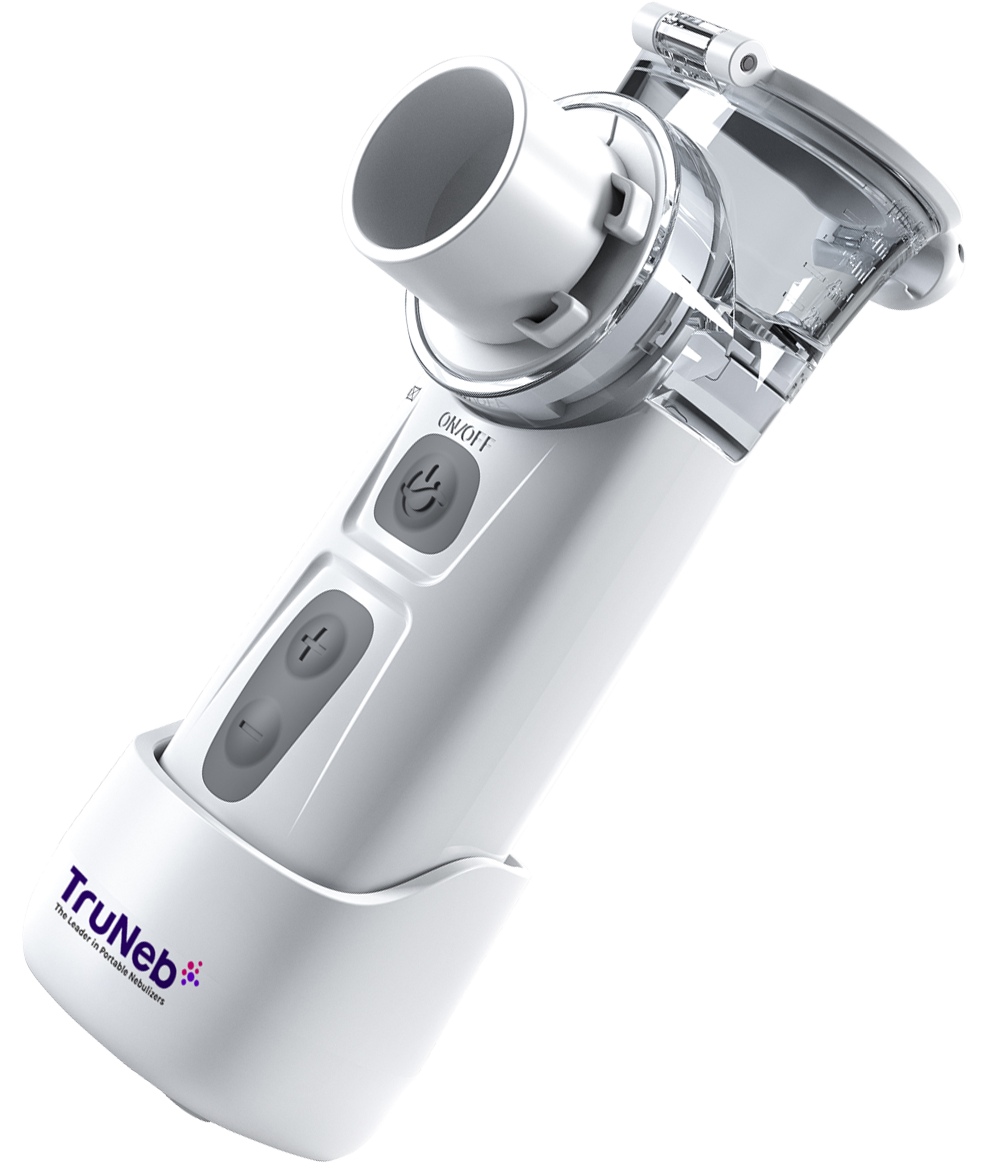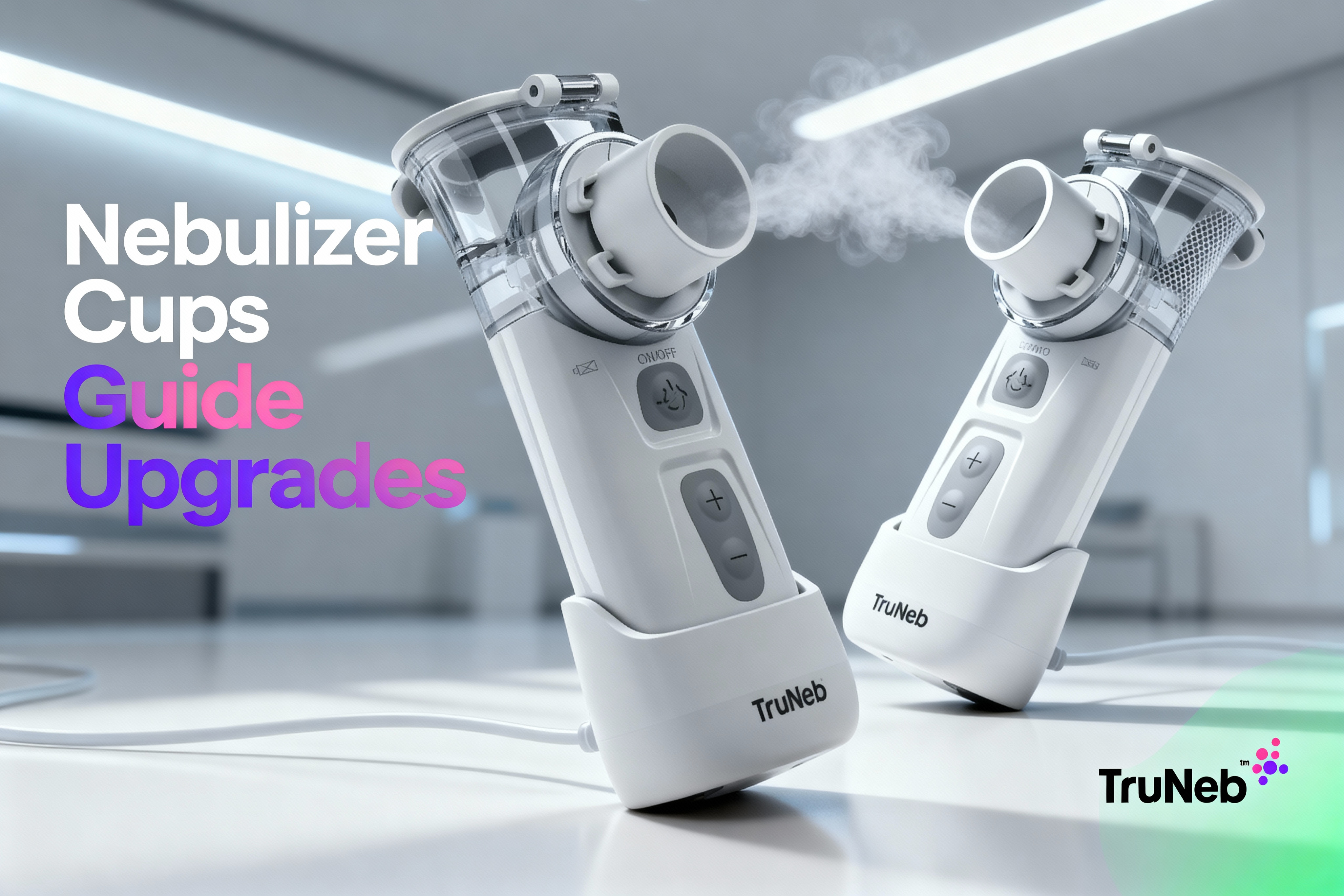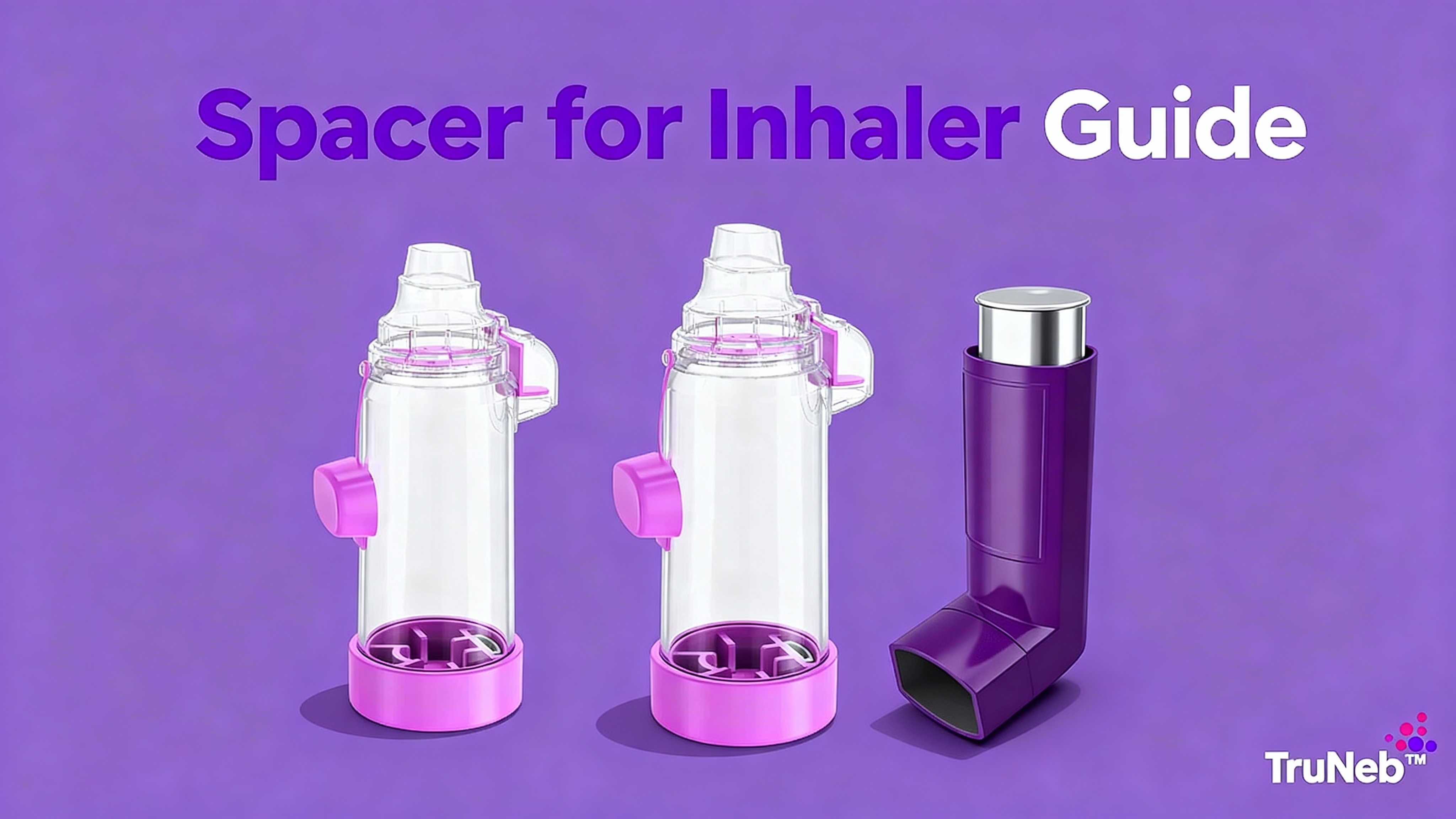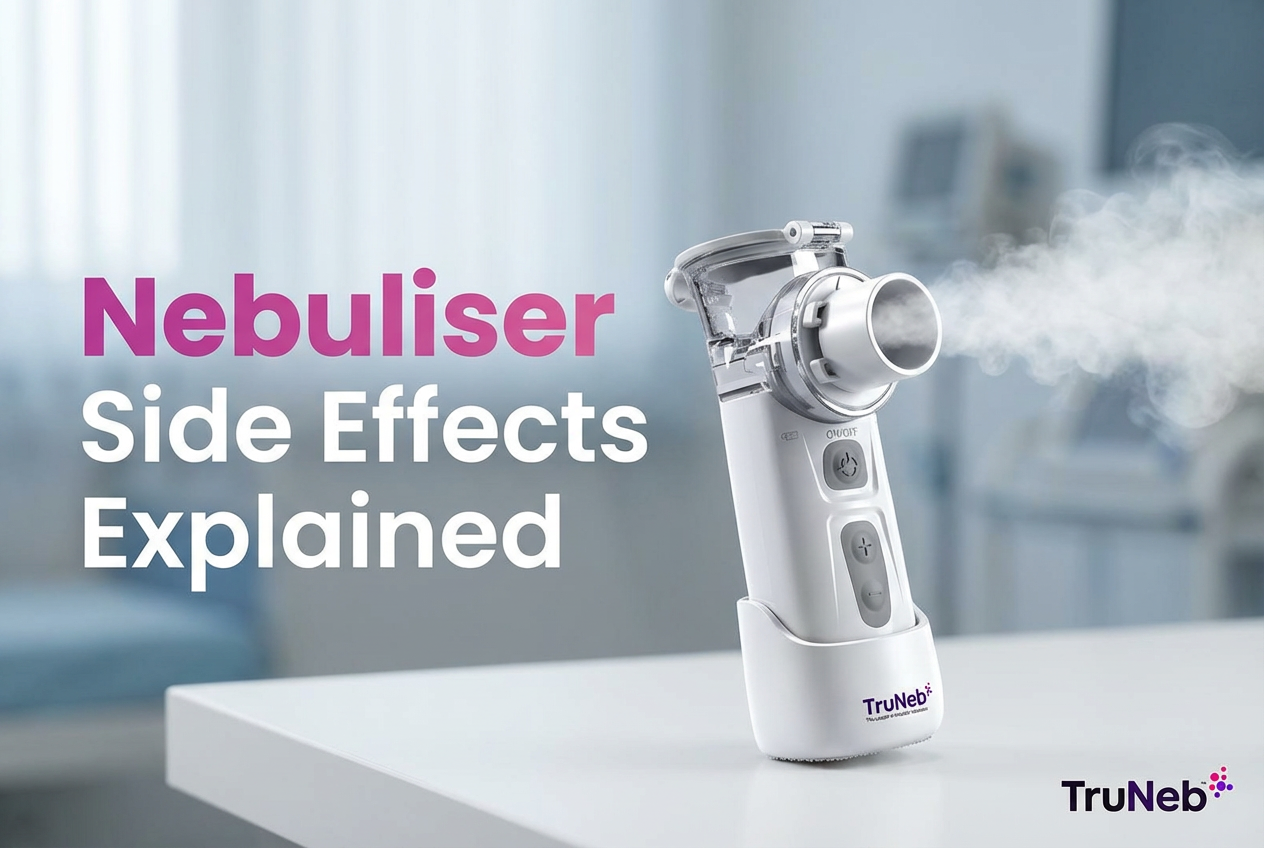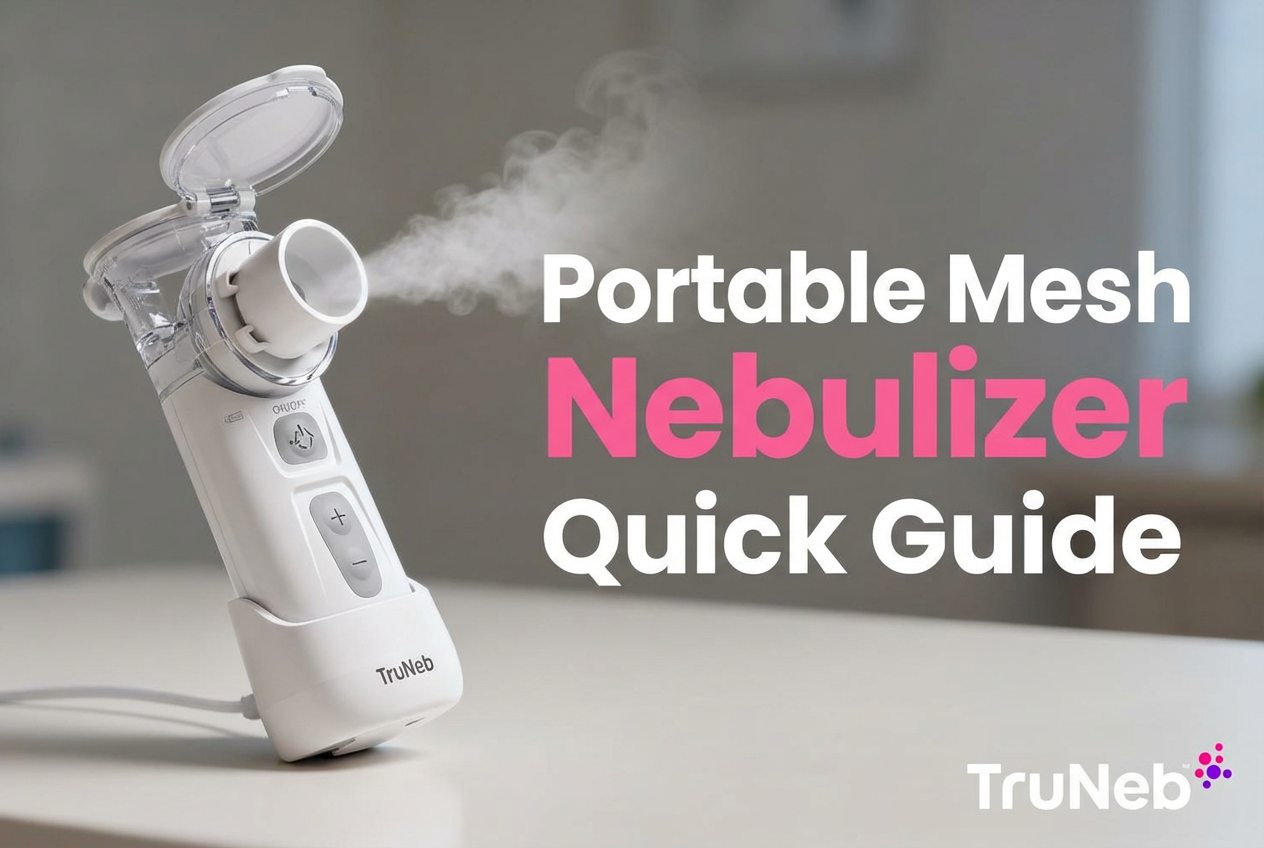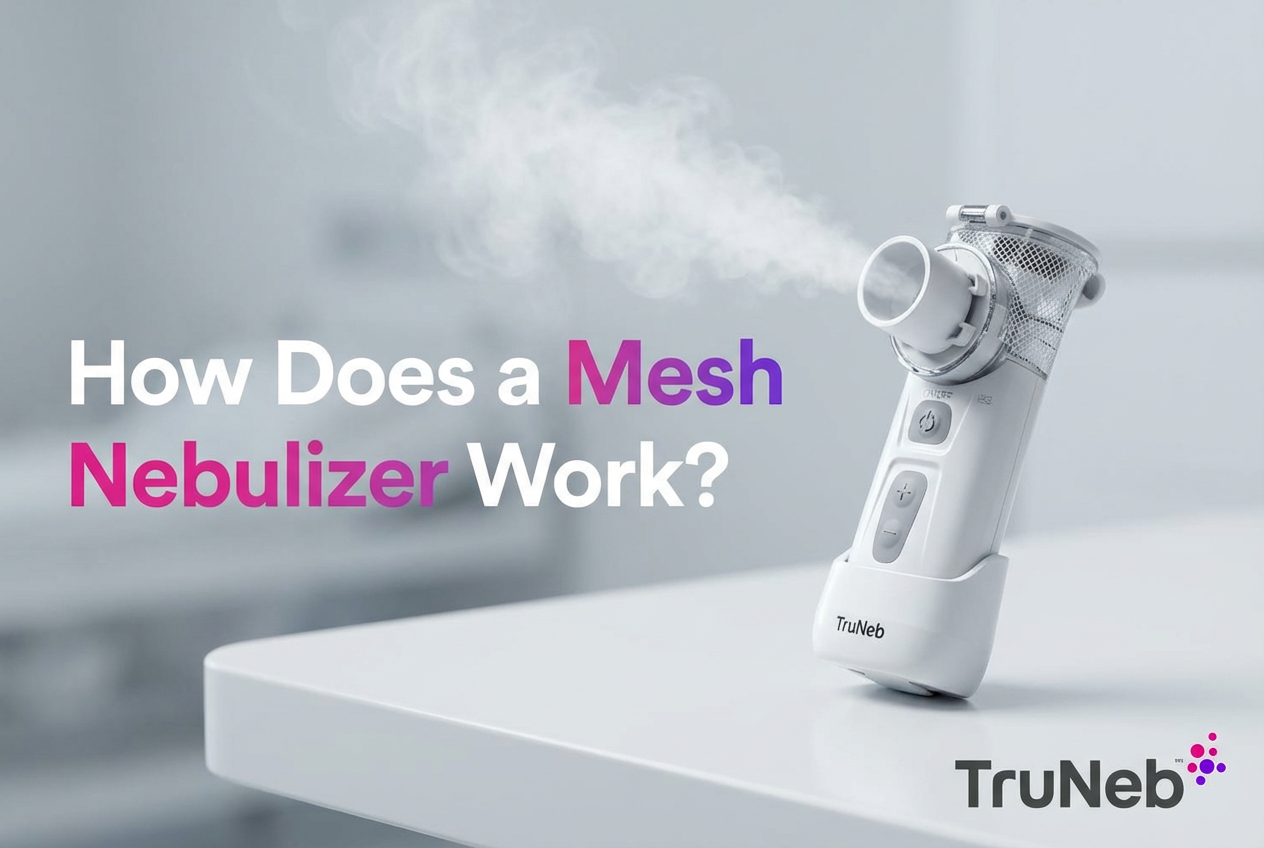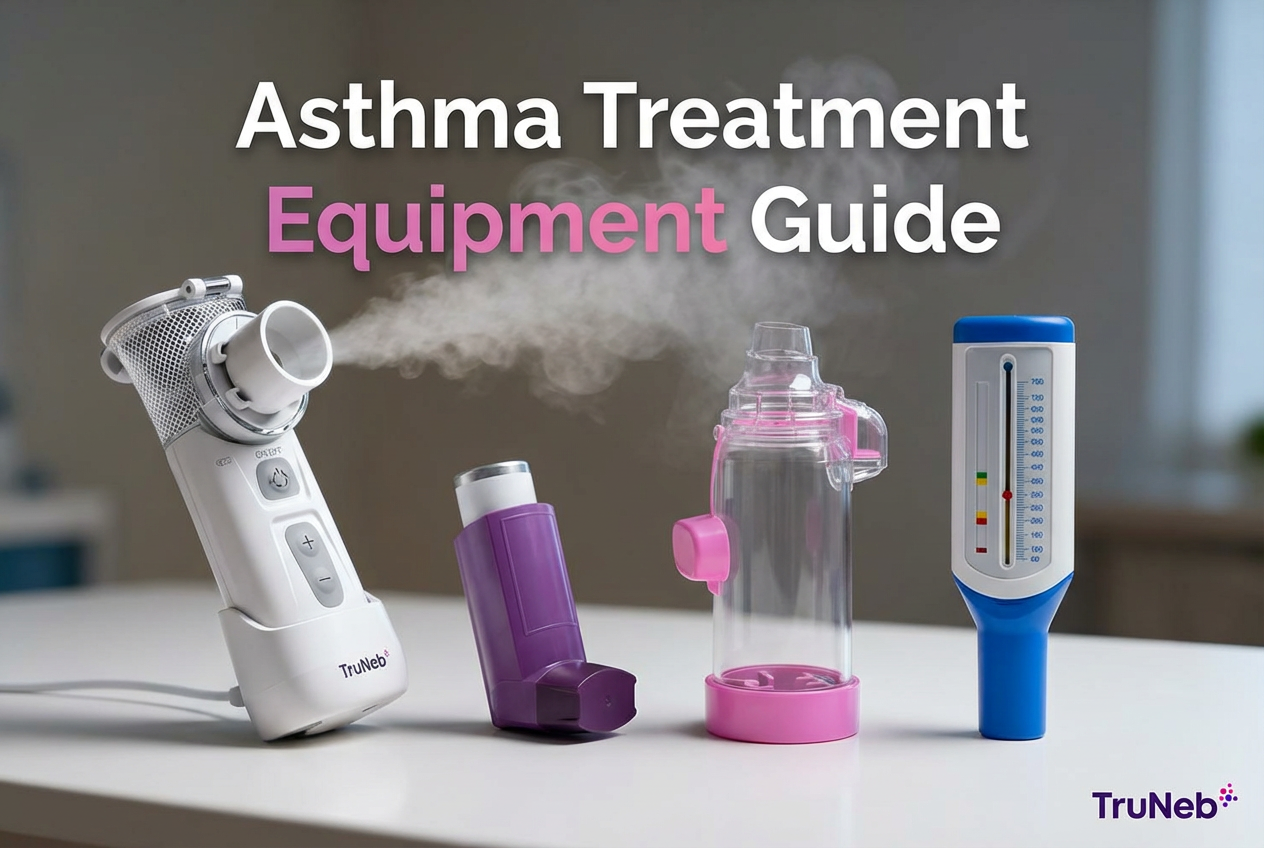On this page
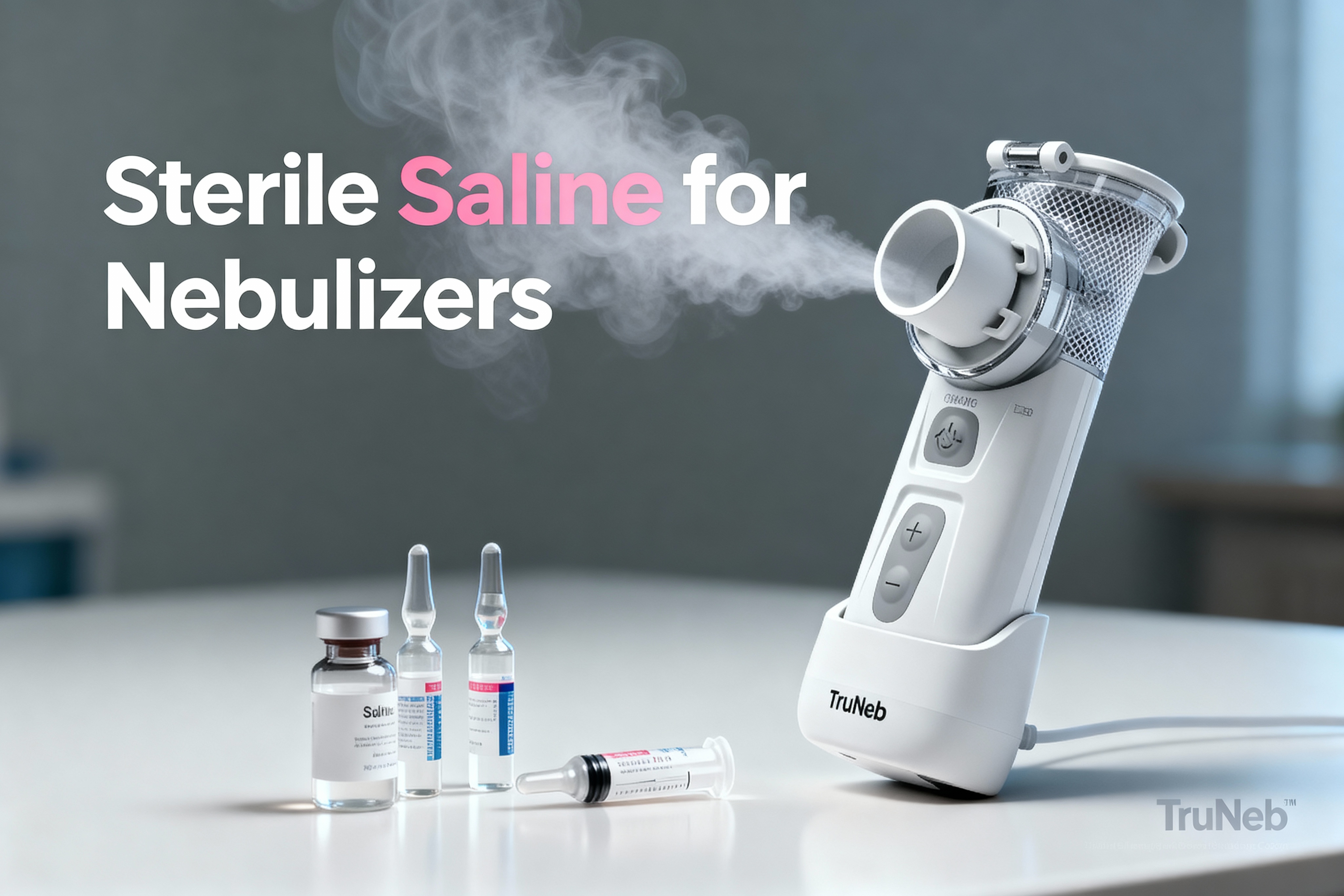
Sterile Saline for Nebulizer Use: What It Is
Sterile saline for nebulizer use is a medical-grade saltwater solution you inhale as a fine mist. Most people use normal saline, which is 0.9% sodium chloride, so it matches your body’s natural salt level. A nebulizer turns this liquid into tiny droplets you breathe in through a mouthpiece or mask.
It’s sterile and labeled for inhalation—this matters. Don’t use tap water, contact lens solution, or homemade mixes in a nebulizer.
Rule of thumb: Normal saline is 0.9% sodium chloride made for inhalation and comes in sterile, single-use vials.
If you want a quiet, portable setup, a mesh nebulizer like the TruNeb™ Portable Mesh Nebulizer can make saline treatments easier at home or on the go.
Sterile saline for nebulizers is 0.9% sodium chloride packaged sterile for inhalation via a nebulizer.
How Nebulizing Saline Helps Your Lungs
Breathing in saline mist adds moisture to dry or irritated airways. The salt pulls water onto airway surfaces, which can thin thick mucus. When mucus is thinner, tiny hairs in your lungs (cilia) can move it up and out. This can ease cough, chest congestion, and that scratchy, tight feeling.
Think of it like a gentle lung humidifier. Saline isn’t a bronchodilator, so it doesn’t replace asthma or COPD medications prescribed by your doctor. Some people with COPD use saline for moisture under a doctor’s care, but it’s not a substitute for rescue or controller inhalers.
You might use saline when:
- Your cough feels dry and irritating.
- You’re stuffed up from a cold.
- Dry air makes breathing uncomfortable.
Nebulized saline adds moisture and helps thin mucus so it’s easier to clear.
| Saline type | NaCl % | Best for | How to get | What to expect |
|---|---|---|---|---|
| Normal (isotonic) | 0.9% | Moisturizing airways; mild cough/congestion; diluting certain meds | OTC single‑use vials at pharmacies or online | Gentle; usually well tolerated |
| Hypertonic | 3% | Thick mucus; mucus clearance support; bronchiolitis care1 | May require prescription or doctor guidance2 | More coughing (helps clear mucus); salty taste; possible throat irritation |
| Hypertonic | 7% | Cystic fibrosis; bronchiectasis under specialist care | Typically prescription/special order2 | Stronger mucus thinning; may irritate or tighten airways in some users3 |
1 Commonly used in clinical settings; follow pediatric guidance for infants. 2 Availability varies by region and prescriber. 3 Stop and seek medical advice if chest tightness or wheeze occurs.
Isotonic vs. Hypertonic Saline: What’s the Difference?
Isotonic saline (0.9%) matches your body’s salt level. It mainly adds moisture and helps loosen light to moderate mucus. It’s a common, gentle choice and is usually sold over the counter in single-use vials.
Hypertonic saline (3% or 7%) has more salt. The extra salt draws more water into the airway surface, which can thin very thick mucus so it’s easier to cough up. Doctors often use 3% or 7% for cystic fibrosis or bronchiectasis. Hospitals sometimes use 3% saline in bronchiolitis care. It can cause more coughing or a salty taste. People with sensitive airways can feel chest tightness.
Simple guide: Use 0.9% for routine moisture, and ask your doctor about 3% or 7% if you need stronger mucus clearance. See the comparison table above.
TruNeb offers sterile saline in 0.9% and hypertonic strengths your doctor might recommend.
Use 0.9% saline for gentle moisture. 3% or 7% saline is stronger for thick mucus and should be guided by a doctor.
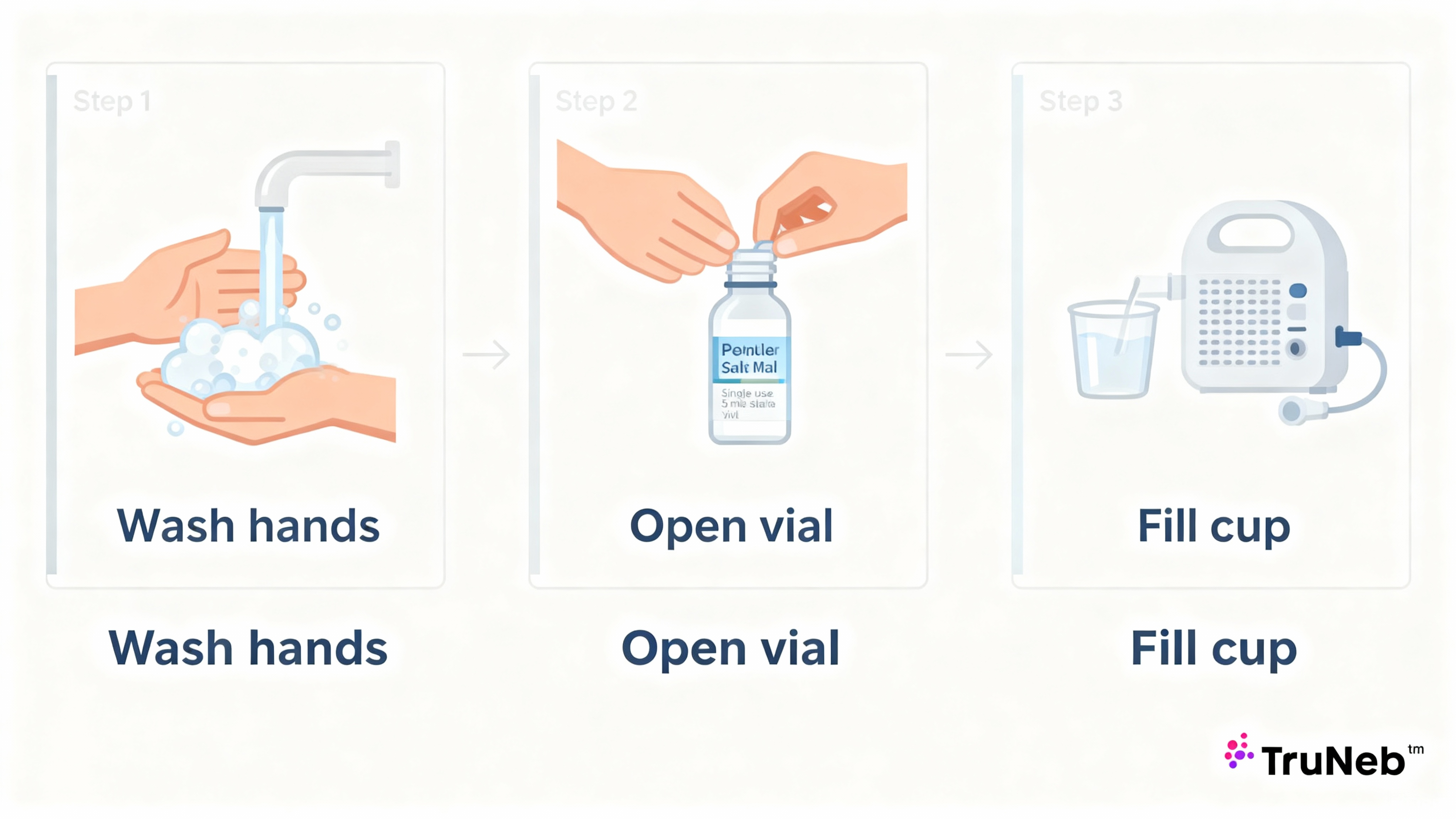
How to Use Sterile Saline in Your Nebulizer
Follow these steps for a smooth, safe treatment:
- Wash your hands. Clean hands help keep the saline sterile.
- Gather supplies. Nebulizer, cup, mask or mouthpiece, and a unit-dose saline vial (often 5 mL).
- Open the vial. Twist or snip the top. Use a fresh, single-use vial each session.
- Fill the cup. Pour saline into the nebulizer’s medication chamber.
- Assemble and start. Attach parts. If using a portable mesh nebulizer like TruNeb, power it on once filled.
- Breathe the mist. Seal lips around the mouthpiece (or use the mask). Inhale slowly, exhale normally, for about 5–10 minutes until the cup is empty.
- Clean up. Discard leftovers. Rinse parts per your device instructions and air-dry.
Quick safety note: Use only sterile saline labeled for inhalation.
Use a new sterile vial each session and clean your nebulizer afterward to avoid germs.
Safety Tips, Side Effects, and Precautions
- Common effects: Mild throat tickle, salty taste, or coughing as mucus loosens.
- Rare effects: Bronchospasm (chest tightness) in sensitive airways. Stop and contact your doctor if this happens.
- Best practices:
- Use single-use vials and discard leftovers.
- Keep equipment clean to lower infection risk. Disinfect parts regularly as the manufacturer recommends.
- Check labels for "Inhalation Solution USP, sterile"—not for injection.
- Steam inhalers aren’t nebulizers—don’t use them for breathing medications.
- Special groups: Normal saline is generally considered safe in pregnancy and widely used in infants under medical guidance. Sterile saline inhalation is drug-free and generally considered compatible with breastfeeding; check with your doctor if you have questions.
- When to get help: If symptoms don’t improve, or you’re considering hypertonic saline, talk with your doctor.
⚠️ If you have severe trouble breathing, blue lips/face, high fever, or symptoms that worsen quickly, seek emergency care.
Saline is generally safe; stop and contact your doctor if you feel chest tightness or breathing gets worse.
Buying Sterile Saline (OTC) and Storing It Right
Normal saline (0.9%) for nebulizers is usually sold over the counter at pharmacies in unit-dose vials. You can also find it through medical supply stores or reputable online retailers. Hypertonic saline (3% or 7%) can require a prescription or doctor guidance and is commonly ordered through specialty suppliers.
What to look for:
- The label should say "Sodium Chloride Inhalation Solution USP, sterile" and single-use.
- Choose unit-dose vials to reduce contamination risk.
Storage basics:
- Keep at room temperature.
- Discard any vial that’s cloudy, cracked, or past its expiration.
TruNeb offers sterile saline options and a portable mesh nebulizer that makes daily treatments easier.
Choose single-use vials labeled "Sodium Chloride Inhalation Solution USP, sterile," and store them at room temperature.
Frequently Asked Questions
Tap or click a question below to see the answer:
Yes. Lots of people nebulize sterile normal saline alone to add moisture and loosen mucus. It can help a dry cough or mild congestion without medication.
Some people use isotonic (0.9%) saline up to a few times a day for symptom relief; ask your doctor what’s right for you. Hypertonic saline (3% or 7%) is usually 1–2 times daily under medical guidance.
Yes—under pediatric guidance. Normal saline is commonly used for infants with bronchiolitis to help clear congestion. Use an infant mask and keep the child calm.
No. Homemade or non-sterile solutions can carry germs or additives that irritate lungs. Use sterile vials labeled for inhalation.
No. Saline hydrates airways and helps loosen mucus, but it isn’t a bronchodilator. Keep using rescue and controller medications as prescribed.
No. Nebulizer saline is sterile and preservative-free for inhalation into the lungs. Nasal sprays may contain preservatives and are for the nose only; don’t put them in a nebulizer.
No. Steam inhalers warm and humidify room air. Nebulizers turn sterile solutions into a fine mist you breathe into your lungs for therapies like saline or medications.
Disclaimer: This article is for informational purposes only and isn’t a substitute for professional medical advice. Always talk with your doctor about your symptoms, treatments, and devices.

